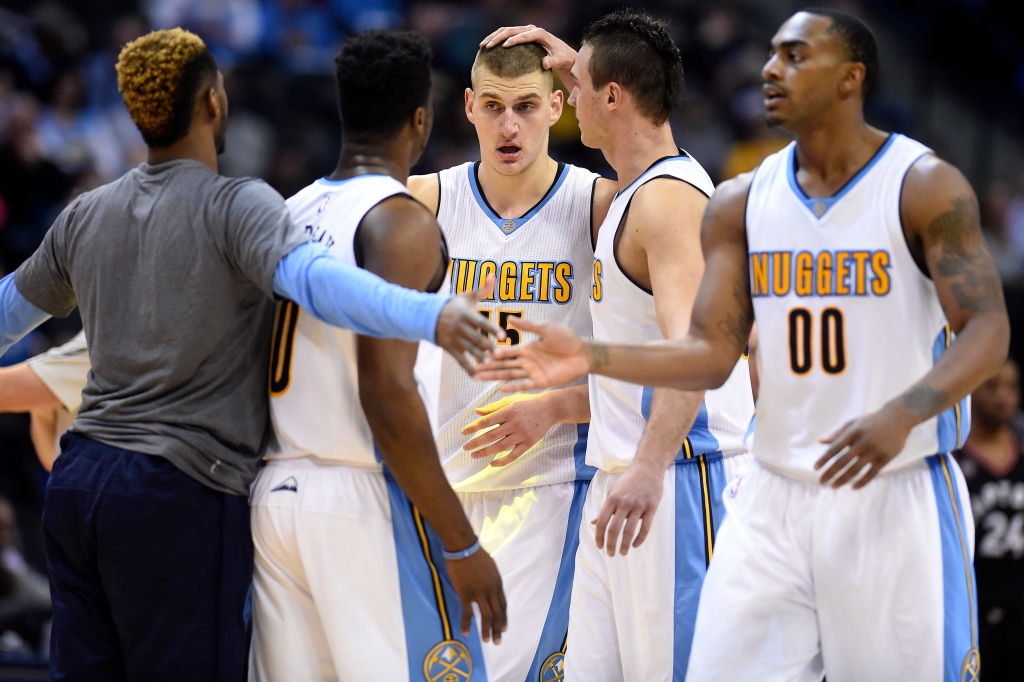
Nuggets’ championship was born way back in 2016 with a crazy idea
[ad_1]
A championship parade through the streets of Denver that will make Nuggets Nation cheer and clap louder than thunder began with one bold step on a sad day in Dallas nearly seven years ago.
This is the story of the precise moment when a fly-over NBA city gambled everything on a 21-year-old Serbian forward with a soft shooting touch and a softer belly.
As the Nuggets get ready to parade the shiny gold Larry O’Brien trophy through downtown, I’m here to tell you that maybe the most momentous date in team history is Dec. 12, 2016, when a struggling team searching for answers got blown out by 30 on the road against the Mavericks.
That’s when the brain trust of Nuggets president Josh Kroenke, general manager Tim Connelly and coach Michael Malone leaned hard into the analytics and embraced a radical hypothesis many in the league would dispute to this day:
Nikola Jokic is the second coming of Larry Bird.
“(Connelly and I) sat down and looked at the analytics. We were trying to play two talented big guys in the starting lineup at the same time and it wasn’t working, when everybody in the league was going small because of Golden State’s success,” Kroenke told me Monday night, in a champagne-drenched locker room after the Nuggets beat Miami 94-89 to close out the NBA Finals in five games.
“… At that point, Nikola was coming off an all-league rookie season. We had a data set on him we could really look at, about a year and a half of play. So we did a Player A and Player B comparison, standardized to 36 minutes per game production, looking at everything.”
The findings were jaw-dropping.
“The only caveat was Player A played basketball for four years in college and was two years older than Player B at the time of their second seasons in the NBA. But the same point in their careers, you could clearly see that Player B was better than Player A, based on the physical evidence,” recalled Kroenke, his eyes twinkling with the memory.
“Player B was Nikola Jokic. Player A was Larry Bird.”

With little more to rely on except a page of outrageously optimistic data points and gut instinct, the Nuggets dared to dream a second-round draft choice could grow up to be Bird, revered for being the league’s MVP three times and leading the Celtics to three championships on his way to enshrinement in the Hall of Fame.
Was it a crazy notion? You bet.
A little more than a month earlier, shortly before Thanksgiving 2016, Jokic went to Malone and volunteered to give up his spot in the starting lineup as a power forward alongside center Jusuf Nurkic.
In defiance of the league trend, the Nuggets were futilely trying to to build a winner around twin towers, by playing Jokic out of position at forward. Long before he grew into “a triple-double machine” admired by Heat coach Erik Spoelstra, a young Jokic already saw everything on the court unfold more clearly than anyone else. At age 21, he convinced Malone to shelve the twin towers experiment after a November loss to those ballyhooed Warriors in which Jokic scored only a single basket and two free throws during 18 unproductive minutes.
But shortly thereafter, on that sad December night in Dallas when the Nuggets’ record dropped to 9-16, the team’s brain trust committed to an idea that changed everything. Armed with analytics that suggested an under-utilized reserve could be as productive as Bird, Malone looked himself in the mirror and asked: “What am I doing?”
Three days later, when Denver returned home to play Portland, Malone re-inserted Jokic as a starter at his natural position of center and benched Nurkic. It was a move that so upset Nurk, a 2014 first-round pick, that the relationship with the Bosnian Beast and the team soon ended in a messy divorce.
On Dec. 12, 2016, the Nuggets decided to bet everything on Jokic.
“And that’s when our team took off,” Malone recalled at the outset of the NBA Finals. “He became the focal point of everything we did.”
The Nuggets not only re-imagined their offense around an innovative concept Jokic has since mastered as a passing wizard best described as a point center, the organization built its winning culture on his broad shoulders.
So it’s not a stretch to suggest the first championship in the franchise’s 56-year history is the by-product of a bromance between a coach who’s as saucy as a slice of New York pizza and a gentle giant who’d rather be in Serbia cleaning out his horse stables than take a ride on a fire truck along a raucous victory parade route.
While Malone now calls it the best decision of his coaching life, it took guts to entrust his job to a 21-year-old who had only shown flashes of brilliance up until then. A center now lauded as half Tim Duncan, half Magic Johnson and totally amazing never would’ve grown into a 6-foot-11 basketball unicorn without the brave commitment of Malone.
“The guy gave me everything,” Jokic told me back in 2021, shortly before he won the first of back-to-back MVP trophies. Malone “gave me the freedom, he showed me the way. We built a great relationship, not just he’s the coach and I’m a player. We are friends, too. It’s more than basketball.”
This is a basketball love story conceived in analytics that resonated with the logical left side of the organization’s brain, then was brought to life by the creative sorcery of a big Serbian’s imagination in a potent mix of science and art.
The payoff?
On Denver streets long paved with the fatalism that a championship could never happen here, Nuggets Nation will gather during a parade to be bedazzled by the O’Brien trophy’s beautiful gold basketball, shining in the Colorado sun.
Want more sports news? Sign up for the Sports Omelette to get all our analysis on Denver’s teams.
[ad_2]
Source link




